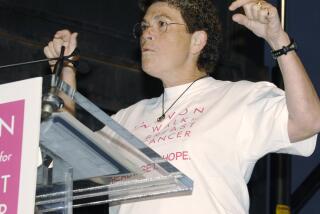Doctors help rebuild lives too
- Share via
Cancer patients often face two gigantic hurdles in the fight against disease. First comes treatment to stay alive. Next is life after treatment.
And for patients such as Sandra Smith, who lost most of her jaw and the floor of her mouth to oral cancer, living now includes smiling, speaking clearly and chewing tender meat with replacement parts that move and function almost as well as the originals.
Smith and about 6 million other people across the United States are beneficiaries of advances in reconstructive surgery that some doctors say they could not have imagined 10 years ago.
The ability to create Smith’s new, living jawbone; to rebuild breasts without destroying abdominal muscles; and to restore function to damaged limbs or fingers hinges on the relatively newfound ability of doctors to stitch together veins and arteries whose diameters are about the size of the tip of a ballpoint pen.
“Reconstructive surgery has never been more exciting,” said Dr. Allen Van Beek, a Minnesota plastic and reconstructive surgeon and president of the Plastic Surgery Educational Foundation, an arm of the American Society of Plastic Surgeons. “It goes well beyond what would have been possible without the advent of microsurgery.”
Microsurgery is used in such cases as when a person loses a finger in an accident. A surgeon in Boston started experimenting with replacing and restoring function to severed fingers in the 1950s. But it wasn’t until the 1980s that researchers began to perfect the optics and the tools that allow doctors to see and stitch together thread-thin vessels.
Doctors also have increased their understanding of how tissue lives and receives blood. Material developed to suture the vessels is now one-half the diameter of a strand of human hair, said Dr. Rajiv Chandawarkar, a plastic surgeon at the University of Connecticut Health Center in Farmington.
Someday, Van Beek said, the technology could allow doctors to transplant hands or arms the same way they might transplant a donated kidney. Other researchers are experimenting with replacing the entire faces of people disfigured by burns or other mishaps.
Smith was first diagnosed with jaw cancer 20 years ago, at age 27. Then, surgeons replaced her diseased jaw with a titanium plate and bone grafted from her hip. The cosmetic replacement looked good, but Smith could not use the rebuilt part of her mouth. And she lost feeling in her tongue.
All of that, she says, was a small price to pay for a healthy, happy life that she filled easily, tending bar, raising three children, giving birth to a fourth, who is now 8, and becoming a nurse’s aide at a rehabilitation center near her home in Brooklyn, Conn.
Last December, she was told that the cancer had recurred at the edges of the titanium plate. This time, Smith was ready for a fight. She was not prepared to come away from the ordeal with a jaw that felt and worked almost as well as the healthy one she was born with.
When she went to see her surgeon, Dr. Jeffrey Spiro, at the University of Connecticut Health Center, she was offered a consultation with Chandawarkar, who had moved to Connecticut just a few months earlier from the M.D. Anderson Cancer Center at the University of Texas in Houston.
Chandawarkar trained in India, where head and neck cancer is common because of the widespread use of chewing tobacco and various chewing roots there. He said he believed every patient facing cancer surgery should see a plastic surgeon before any tumor is removed.
“The surgical oncology guy is going to take a portion of [their tissue] away, the radiologist is going to burn them, the medical oncologist is going to poison them. Shouldn’t they see a guy who’s going to put them back together?” Chandawarkar asked.
Before they could rebuild Smith’s face, Spiro and Chandawarkar removed her old jaw from her chin to her cheek. They also took out the floor of her mouth and the lymph nodes in her neck.
The doctors then moved down to her leg, where they isolated the fibula, the slender bone between the knee and the ankle. They did not disturb the more important of the shin bones, the tibia. They made sure to take the arteries and veins that supplied the fibula and surrounding skin.
Before severing the blood vessels from the leg, the doctors cut the bone into small pieces. The pieces were cut at angles and attached to a titanium mold of Smith’s jaw. Chandawarkar likened the process to using a miter saw to form well-fitting corners when installing crown molding in a home.
Next, they cut the vein and artery from the leg and put the replacement jaw in place, carefully reattaching the vessels to those that supply blood to Smith’s face.
“All you need is an artery and vein that will feed the tissue,” Chandawarkar said.
Using the same approach, doctors can rebuild breasts disfigured by mastectomy by removing skin and fat from the belly, but leaving behind all but a small amount of muscle that surrounds one blood vessel needed to supply the new breast.
At M.D. Anderson, doctors are experimenting with using a similar approach to borrow a small, relatively unimportant nerve from the foot to replace the nerve near the prostate that is responsible for causing erections in men. The nerve is commonly damaged during surgery for prostate cancer, causing impotence.
Chandawarkar said the early results were promising.
Smith said she was happy when she looked in the mirror, and was even more amazed by the renewed sensation in her rebuilt jaw. “It’s different,” she said, “it’s living bone and tissue.”
The operation, she said, has renewed her faith and her certainty that cancer is a disease to live with, not to die from.
“I really think people should know you can get through it,” Smith said. “It’s a fight, but live through it, and get past it.”






